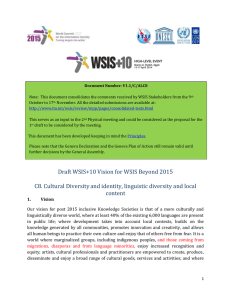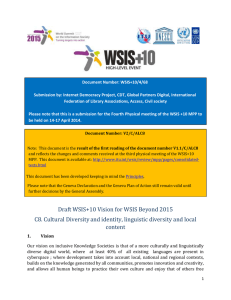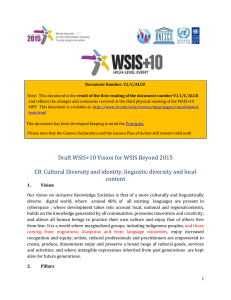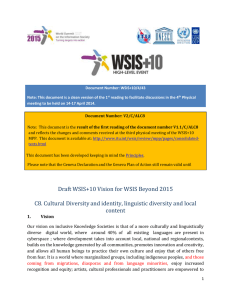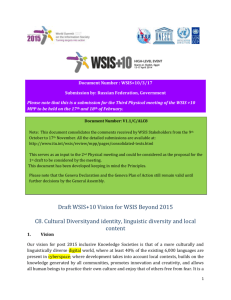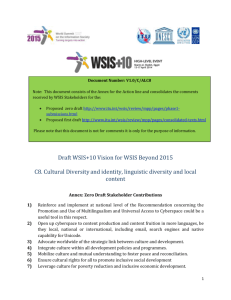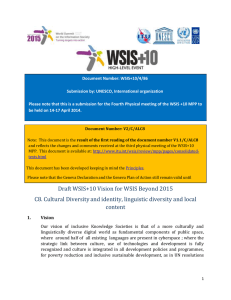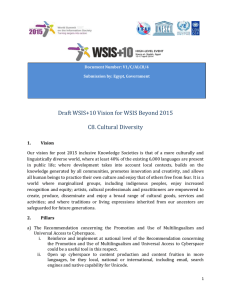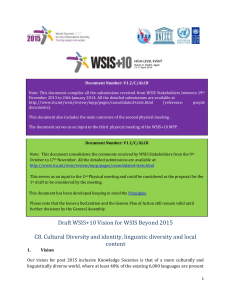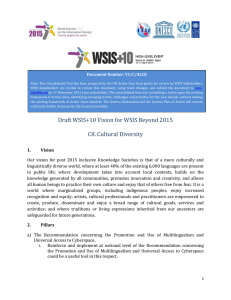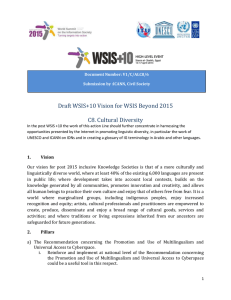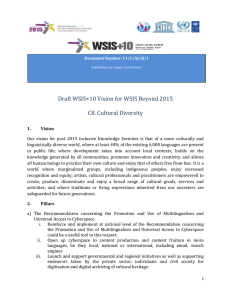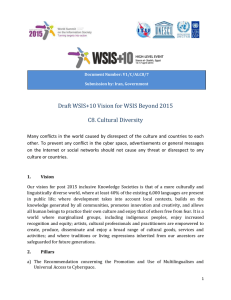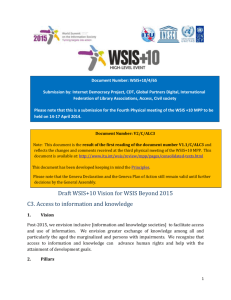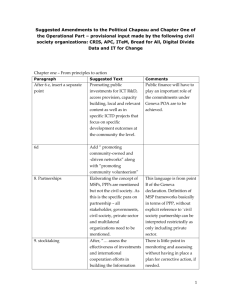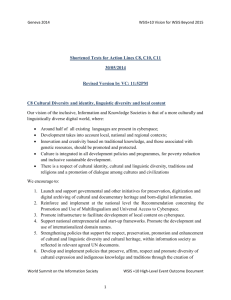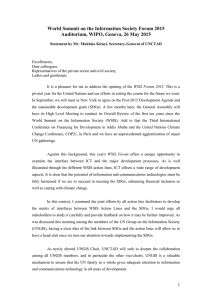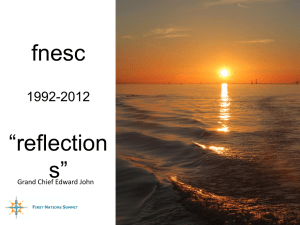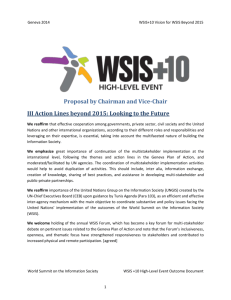Document Number : WSIS+10/3/57 Submission by: Canada
advertisement
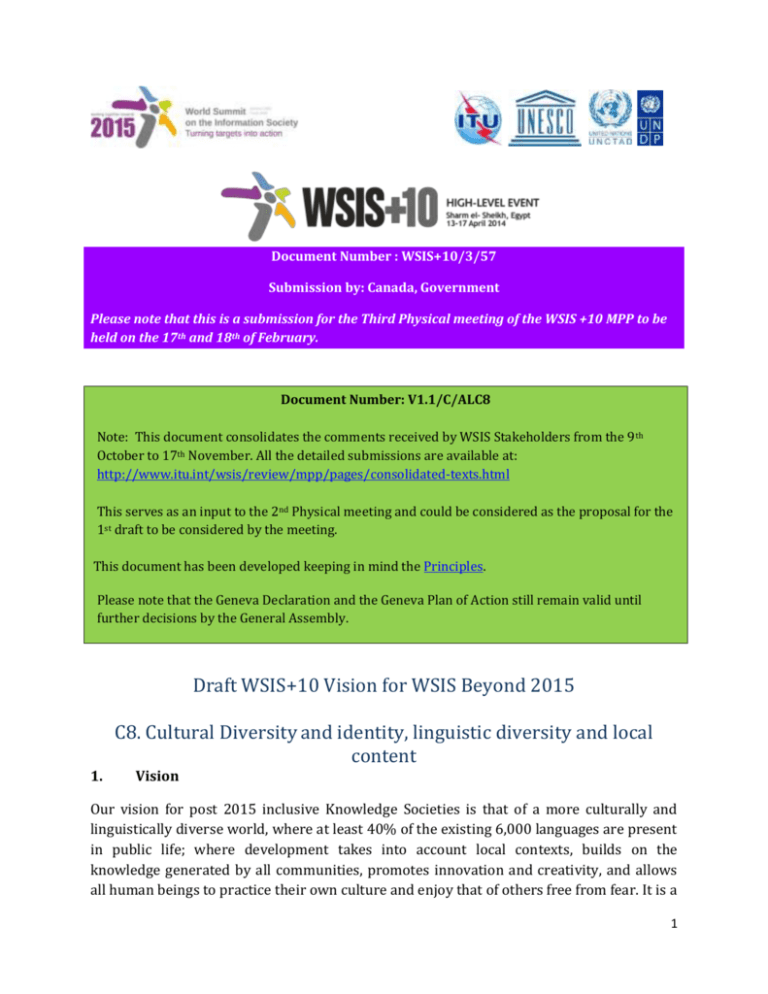
Document Number : WSIS+10/3/57 Submission by: Canada, Government Please note that this is a submission for the Third Physical meeting of the WSIS +10 MPP to be held on the 17th and 18th of February. Document Number: V1.1/C/ALC8 Note: This document consolidates the comments received by WSIS Stakeholders from the 9th October to 17th November. All the detailed submissions are available at: http://www.itu.int/wsis/review/mpp/pages/consolidated-texts.html This serves as an input to the 2nd Physical meeting and could be considered as the proposal for the 1st draft to be considered by the meeting. This document has been developed keeping in mind the Principles. Please note that the Geneva Declaration and the Geneva Plan of Action still remain valid until further decisions by the General Assembly. Draft WSIS+10 Vision for WSIS Beyond 2015 С8. Cultural Diversity and identity, linguistic diversity and local content 1. Vision Our vision for post 2015 inclusive Knowledge Societies is that of a more culturally and linguistically diverse world, where at least 40% of the existing 6,000 languages are present in public life; where development takes into account local contexts, builds on the knowledge generated by all communities, promotes innovation and creativity, and allows all human beings to practice their own culture and enjoy that of others free from fear. It is a 1 world where marginalized groups, including indigenous peoples, and those coming from migrations, diasporas and from language minorities, enjoy increased recognition and equity; artists, cultural professionals and practitioners are empowered to create, produce, disseminate and enjoy a broad range of cultural goods, services and activities; and where intangible expressions inherited from past generations are kept alive for future generations. 2. Pillars a) The Recommendation concerning the Promotion and Use of Multilingualism and Universal Access to Cyberspace. i. Reinforce and implement at national level of the Recommendation concerning the Promotion and Use of Multilingualism and Universal Access to Cyberspace could be a useful tool in this respect. ii. Open up cyberspace to content production and content fruition in more languages, be they local, national or international, including email, search engines in diverse coding formats. i. Launch and support governmental and regional initiatives as well as supporting endeavors taken by the private sector, individuals and civil society for. preservation, digitization and digital archiving of cultural heritage and borndigital information. ii. iii. iv. v. vi. vii. Streamline DAC initiatives and programmes launched and/or implemented by different international and regional organizations such as LAS, ESCWA, ITU, ALECSO and AICTO. Develop region-wide standards for developing digital content specific to the vehicular languages that will enhance quality, interoperability, and inter-regional collaboration. Promote infrastructure to facilitate development of local content, given the relationship between the deployment of Internet infrastructure and the development of local digital content, in particular broadband and cloud computing. Support national entrepreneurial and start-up ecosystem to help the digital content industry to flourish, including incubators, accelerators, mentorship, investments, and venture capital, focusing on DAC applications and emphasizing the recent technology trends such as mobile devices, tablet computers, and cloud computing. Develop appropriate policies and procedures to help converting saved documents from analogue to digital system. Consider the inclusion of protection of digital heritage in a normative instrument on documentary heritage. b) The UN Declaration on the Rights of Indigenous Peoples. i. Promote the principles of the UN Declaration on the Rights of Indigenous Peoples, relevant in the context of WSIS and the ICT landscape. In particular, through work to : 2 i. Close the digital divides with regard to Indigenous Peoples. ii. Support the full and effective participation of Indigenous Peoples in the WSIS process and beyond. iii. Foster policies and programmes that promote media pluralism including Indigenous media. iv. Ensure protection, as appropriate, of traditional knowledge. v. Ensure that Indigenous knowledge is recognized to have an important place in inclusive knowledge societies. vi. Support the right to take part in cultural life to promote inclusive social development. c) The Convention on the Protection and Promotion of the Diversity of Cultural Expressions. i. Advocate worldwide of the strategic link between culture and development. ii. Integrate culture within all development policies and programmes. iii. Leverage culture for poverty reduction and inclusive economic development iv. Build on culture to promote sustainable development. v. Harness culture as a resource for achieving sustainable Enable local content production with measures at governmental and community level. vi. Develop North-South, and South-South cooperation to enhance the capabilities of developing countries to protect and promote the diversity of cultural expressions. vii. Promote the public service value of a diversity of media in the digital realm and the importance of freedom of expression. d) The Convention for the Safeguarding of Intangible Cultural Heritage. i. ii. iii. iv. v. Value, safeguard and transmit culture to future generations. Capitalize on culture to foster innovative and sustainable models of cooperation. Focus national policy on languages as a strategic factor for development policy. Mobilize culture and mutual understanding to foster peace and reconciliation. Bridge differences and discrepancies among the objectives of the diverse stakeholders in the field of linguistic policies worldwide, to create a global platform for joint action. 3. 3
